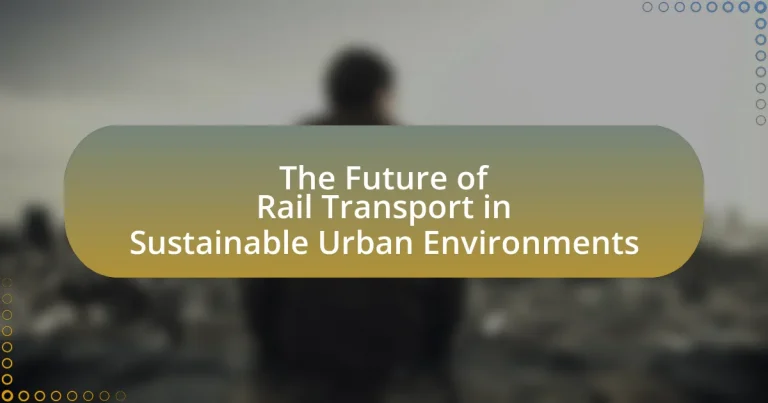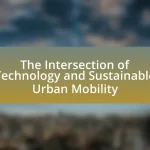The article focuses on the future of rail transport in sustainable urban environments, highlighting the transition towards electrification, integration with other transport modes, and the adoption of advanced technologies. Key developments include the shift to fully electric operations, the use of renewable energy sources, and innovations such as automated trains and real-time data analytics, which enhance efficiency and safety. The article also addresses the importance of sustainable rail transport in reducing greenhouse gas emissions, alleviating traffic congestion, and improving urban living conditions, while discussing the challenges and financial barriers faced in implementing these systems. Additionally, it explores the role of urban planning and community engagement in integrating rail transport into sustainable development strategies.

What is the Future of Rail Transport in Sustainable Urban Environments?
The future of rail transport in sustainable urban environments is characterized by increased electrification, integration with other modes of transport, and the adoption of advanced technologies. Rail systems are expected to transition to fully electric operations, reducing greenhouse gas emissions and reliance on fossil fuels. For instance, cities like Amsterdam and Paris are investing in electric trains and tram systems, which contribute to cleaner air and lower carbon footprints. Additionally, the integration of rail with cycling and bus networks enhances accessibility and encourages public transport use, as seen in cities like Copenhagen. Advanced technologies such as automated trains and real-time data analytics will improve efficiency and safety, as demonstrated by projects in cities like Singapore. These developments indicate a significant shift towards more sustainable and efficient rail transport systems in urban settings.
How is rail transport evolving to meet sustainability goals?
Rail transport is evolving to meet sustainability goals through the adoption of electrification, the use of renewable energy sources, and the implementation of advanced technologies for efficiency. Electrification reduces reliance on fossil fuels, with countries like Germany achieving over 60% of rail lines electrified, significantly lowering greenhouse gas emissions. Additionally, rail operators are increasingly integrating renewable energy, such as solar and wind, into their power supply, exemplified by initiatives in the UK where rail networks are powered by 100% renewable energy. Advanced technologies, including regenerative braking and real-time data analytics, enhance operational efficiency, further reducing energy consumption and emissions. These developments collectively contribute to a more sustainable rail transport system.
What technologies are driving innovation in rail transport?
Technologies driving innovation in rail transport include electrification, automation, and advanced signaling systems. Electrification reduces reliance on fossil fuels, enhancing sustainability; for instance, electric trains emit significantly lower greenhouse gases compared to diesel counterparts. Automation, through the implementation of autonomous trains, increases operational efficiency and safety, as demonstrated by successful trials in various countries. Advanced signaling systems, such as the European Train Control System (ETCS), improve train scheduling and reduce delays, leading to more reliable services. These technologies collectively contribute to a more efficient, sustainable, and modern rail transport system.
How do these technologies contribute to sustainability?
Technologies in rail transport contribute to sustainability by reducing greenhouse gas emissions and enhancing energy efficiency. For instance, electric trains produce significantly lower emissions compared to diesel-powered alternatives, with electric rail systems accounting for approximately 70% of rail transport in Europe, which leads to a substantial decrease in carbon footprints. Additionally, advancements such as regenerative braking systems allow trains to recover energy during braking, further improving energy efficiency. These technologies not only minimize environmental impact but also promote the use of renewable energy sources, aligning with global sustainability goals.
Why is sustainable rail transport important for urban environments?
Sustainable rail transport is crucial for urban environments because it significantly reduces greenhouse gas emissions and traffic congestion. Rail systems, such as electric trains, produce lower emissions compared to road vehicles, contributing to cleaner air and improved public health. For instance, a study by the International Energy Agency indicates that rail transport emits up to 75% less CO2 per passenger kilometer than cars. Additionally, sustainable rail systems promote efficient land use by encouraging higher-density development around stations, which can lead to reduced urban sprawl. This integration of transport and urban planning fosters more walkable communities, enhancing overall quality of life.
What are the environmental impacts of traditional rail systems?
Traditional rail systems have several environmental impacts, primarily including land use changes, habitat disruption, and greenhouse gas emissions. The construction and operation of rail lines often require significant land alteration, which can lead to the destruction of natural habitats and biodiversity loss. For instance, a study by the International Union of Railways indicates that rail infrastructure can fragment ecosystems, affecting wildlife movement and breeding patterns. Additionally, while trains are generally more energy-efficient than road vehicles, traditional rail systems still contribute to greenhouse gas emissions, particularly if powered by fossil fuels. According to the U.S. Environmental Protection Agency, rail transport accounts for approximately 0.5% of total U.S. greenhouse gas emissions, highlighting its environmental footprint.
How can sustainable rail transport improve urban living conditions?
Sustainable rail transport can significantly improve urban living conditions by reducing traffic congestion and lowering greenhouse gas emissions. By providing an efficient alternative to road transport, rail systems can alleviate the burden on urban roadways, leading to decreased travel times and enhanced air quality. For instance, cities that invest in electric rail systems, such as light rail or subways, often report a reduction in vehicle emissions by up to 45% compared to traditional diesel-powered transport. Furthermore, sustainable rail transport promotes higher-density development around transit hubs, which can lead to more walkable neighborhoods and increased access to public services. This urban planning approach not only fosters community engagement but also supports local economies by increasing foot traffic to businesses.
What challenges does rail transport face in urban sustainability?
Rail transport faces significant challenges in urban sustainability, primarily including infrastructure limitations, funding constraints, and competition with other modes of transport. Infrastructure limitations arise from aging rail systems that require modernization to meet current urban demands; for instance, many cities have rail networks that are not equipped to handle increased passenger volumes or integrate with other transit systems effectively. Funding constraints hinder the ability to invest in necessary upgrades and expansions; according to the American Public Transportation Association, public transit systems in the U.S. face a funding gap of approximately $90 billion over the next decade. Additionally, competition with other transport modes, such as buses and ride-sharing services, can divert potential users away from rail, impacting ridership levels and overall sustainability efforts. These challenges collectively impede the potential for rail transport to contribute effectively to sustainable urban development.
What are the financial barriers to implementing sustainable rail systems?
The financial barriers to implementing sustainable rail systems include high initial capital costs, ongoing maintenance expenses, and the challenge of securing funding. High initial capital costs arise from the need for advanced technology, infrastructure upgrades, and compliance with environmental regulations, which can exceed billions of dollars. Ongoing maintenance expenses are significant due to the specialized nature of sustainable technologies, such as electrification and energy-efficient trains, which require continuous investment. Additionally, securing funding is often difficult as public and private investors may prioritize short-term returns over long-term sustainability projects, leading to a lack of financial support. For instance, a report by the International Energy Agency highlights that investment in sustainable transport infrastructure needs to increase by 30% annually to meet climate goals, emphasizing the financial challenges faced in this sector.
How do regulatory frameworks affect rail transport sustainability?
Regulatory frameworks significantly influence rail transport sustainability by establishing standards and guidelines that promote environmentally friendly practices. These frameworks often mandate emissions reductions, energy efficiency improvements, and the adoption of renewable energy sources, which directly contribute to lowering the carbon footprint of rail operations. For instance, the European Union’s regulations on emissions from rail vehicles have led to a substantial decrease in greenhouse gas emissions, with rail transport becoming one of the most sustainable modes of transport. Additionally, regulations can incentivize investments in infrastructure that supports sustainable technologies, such as electrification and advanced signaling systems, further enhancing the sustainability of rail transport.

How can cities integrate rail transport into their sustainable development plans?
Cities can integrate rail transport into their sustainable development plans by prioritizing the development of efficient rail networks that connect urban centers with surrounding areas. This integration can be achieved through strategic planning that aligns rail infrastructure with land use policies, promoting higher-density development near transit stations to reduce reliance on cars. For instance, cities like Copenhagen have successfully implemented integrated transport systems that include rail, resulting in a 62% reduction in carbon emissions from transportation since 1995. Additionally, cities can invest in electrification of rail lines to further decrease greenhouse gas emissions, as seen in the UK, where electrified rail systems have shown a significant decrease in pollution levels. By incorporating rail transport into urban planning, cities can enhance mobility, reduce traffic congestion, and contribute to overall sustainability goals.
What role does urban planning play in rail transport development?
Urban planning plays a crucial role in rail transport development by integrating transportation systems with land use to enhance accessibility and efficiency. Effective urban planning ensures that rail networks are strategically located to serve population centers, thereby promoting higher ridership and reducing reliance on automobiles. For instance, cities that prioritize transit-oriented development, such as Portland, Oregon, have seen a significant increase in public transport usage, with a 30% rise in light rail ridership since the implementation of such planning strategies. This alignment of rail infrastructure with urban growth patterns not only facilitates sustainable mobility but also contributes to reduced traffic congestion and lower greenhouse gas emissions.
How can cities design infrastructure to support rail transport?
Cities can design infrastructure to support rail transport by integrating dedicated rail corridors, enhancing station accessibility, and implementing multimodal transport hubs. Dedicated rail corridors ensure efficient movement of trains by minimizing conflicts with road traffic, which can be seen in cities like Tokyo, where elevated rail lines reduce congestion. Enhancing station accessibility through features such as elevators, ramps, and clear signage improves user experience and encourages ridership, as evidenced by the success of accessible stations in cities like London. Additionally, multimodal transport hubs facilitate seamless transfers between rail and other transport modes, exemplified by the integration of bus and bike-sharing services at major rail stations in cities like Amsterdam, promoting a comprehensive and user-friendly transport network.
What are the best practices for integrating rail with other transport modes?
The best practices for integrating rail with other transport modes include establishing multimodal transport hubs, ensuring seamless ticketing systems, and enhancing connectivity through dedicated infrastructure. Multimodal transport hubs facilitate easy transfers between rail and other transport options, such as buses, trams, and bicycles, thereby improving accessibility and convenience for users. Seamless ticketing systems, which allow passengers to use a single ticket for multiple transport modes, streamline the travel experience and encourage the use of public transport. Additionally, dedicated infrastructure, such as pedestrian pathways and bike lanes leading to rail stations, enhances connectivity and promotes sustainable transport choices. These practices are supported by successful examples in cities like Amsterdam and Tokyo, where integrated transport systems have led to increased public transport usage and reduced congestion.
How can community engagement enhance rail transport projects?
Community engagement can enhance rail transport projects by fostering collaboration between stakeholders, which leads to more effective planning and implementation. Engaging local communities allows for the identification of specific needs and preferences, ensuring that rail services are tailored to enhance accessibility and usability. For instance, studies have shown that projects with strong community involvement, such as the Crossrail project in London, resulted in better alignment with local expectations and increased public support, ultimately leading to smoother project execution and higher ridership rates.
What strategies can be used to involve the public in planning processes?
To involve the public in planning processes, strategies such as public consultations, participatory workshops, and online engagement platforms can be effectively utilized. Public consultations allow stakeholders to voice their opinions and concerns, ensuring that diverse perspectives are considered in decision-making. Participatory workshops facilitate collaborative problem-solving, where community members can work alongside planners to develop solutions that reflect local needs. Online engagement platforms, such as surveys and social media, provide accessible avenues for broader participation, enabling feedback from a wider audience. These strategies have been shown to enhance community trust and improve the quality of planning outcomes, as evidenced by case studies in urban planning where public involvement led to more sustainable and accepted solutions.
How does community feedback influence rail transport design?
Community feedback significantly influences rail transport design by ensuring that the needs and preferences of local populations are integrated into planning and development processes. This feedback can lead to modifications in route selection, station locations, and service frequency, ultimately enhancing user satisfaction and ridership. For instance, studies have shown that when communities are engaged in the design process, projects are more likely to address specific local concerns, such as accessibility and environmental impact, resulting in designs that are more aligned with community values and priorities.

What are the future trends in rail transport for sustainable urban environments?
Future trends in rail transport for sustainable urban environments include the integration of electrification, automation, and the development of multimodal transport systems. Electrification reduces greenhouse gas emissions, with electric trains producing up to 50% less CO2 compared to diesel counterparts. Automation enhances efficiency and safety, as seen in cities like Paris and Tokyo, where automated systems have improved service frequency and reduced operational costs. Additionally, multimodal transport systems, which connect rail with other forms of transport such as buses and bicycles, promote seamless travel and reduce reliance on personal vehicles, further contributing to urban sustainability. These trends are supported by global initiatives aimed at reducing urban congestion and improving air quality, aligning with the goals of sustainable urban development.
How is automation shaping the future of rail transport?
Automation is significantly shaping the future of rail transport by enhancing operational efficiency, safety, and passenger experience. Automated systems, such as driverless trains and predictive maintenance technologies, reduce human error and optimize scheduling, leading to increased reliability and reduced delays. For instance, the implementation of automated train operation (ATO) systems in cities like Paris and Singapore has resulted in improved punctuality rates, with some lines achieving over 95% on-time performance. Furthermore, automation facilitates real-time data analysis, allowing for proactive maintenance that minimizes disruptions and extends the lifespan of rail infrastructure. This shift towards automation aligns with sustainability goals by reducing energy consumption and emissions, as automated systems can optimize energy use during operations.
What are the potential benefits of automated rail systems?
Automated rail systems offer several potential benefits, including increased efficiency, enhanced safety, and reduced operational costs. These systems can operate with higher frequency and precision, leading to improved service reliability and reduced wait times for passengers. According to a study by the International Association of Public Transport, automated systems can increase capacity by up to 30% compared to traditional rail systems. Additionally, automation reduces the risk of human error, which is a significant factor in rail accidents; the U.S. Federal Railroad Administration reported that human factors contribute to approximately 38% of train accidents. Furthermore, automated rail systems can lower maintenance costs through predictive maintenance technologies, which can identify issues before they lead to failures, thus ensuring smoother operations and extending the lifespan of infrastructure.
What challenges does automation present for rail transport sustainability?
Automation in rail transport presents challenges for sustainability primarily through increased energy consumption and potential job displacement. The implementation of automated systems often requires significant energy inputs for advanced technologies, which can counteract sustainability goals aimed at reducing overall energy use. Additionally, the transition to automation may lead to job losses in the rail sector, impacting economic stability and community well-being, which are critical components of sustainable development. Studies indicate that while automation can enhance efficiency, it also necessitates careful consideration of its broader social and environmental implications to ensure that sustainability objectives are met.
What innovations in energy sources are being adopted in rail transport?
Rail transport is increasingly adopting innovations in energy sources such as hydrogen fuel cells, battery-electric systems, and solar power. Hydrogen fuel cells are being implemented in trains like the Alstom Coradia iLint, which emits only water vapor and has a range of approximately 600 miles on a single tank. Battery-electric trains, such as those developed by Bombardier and Stadler, utilize rechargeable batteries to operate on non-electrified tracks, reducing reliance on fossil fuels. Additionally, solar power is being integrated into rail infrastructure, with solar panels installed on station roofs and alongside tracks to generate renewable energy for train operations. These advancements contribute to reducing greenhouse gas emissions and promoting sustainability in urban rail transport.
How do alternative energy sources impact rail transport sustainability?
Alternative energy sources significantly enhance rail transport sustainability by reducing greenhouse gas emissions and reliance on fossil fuels. For instance, electrification of rail systems using renewable energy, such as solar and wind, can decrease carbon emissions by up to 70% compared to diesel-powered trains. Additionally, the adoption of hydrogen fuel cells in rail transport offers a zero-emission alternative, with successful implementations in countries like Germany demonstrating operational efficiency and environmental benefits. These advancements contribute to a more sustainable urban transport framework, aligning with global climate goals and improving air quality in urban areas.
What are the implications of electrification for urban rail systems?
Electrification of urban rail systems significantly reduces greenhouse gas emissions and enhances energy efficiency. By transitioning from diesel to electric trains, cities can lower their carbon footprint, as electric trains produce zero emissions at the point of use. For instance, a study by the International Energy Agency indicates that electrified rail systems can reduce emissions by up to 70% compared to their diesel counterparts. Additionally, electrification often leads to lower operational costs due to reduced fuel expenses and maintenance requirements associated with electric engines. Furthermore, electrified systems can improve service frequency and reliability, as electric trains typically have faster acceleration and deceleration capabilities. This shift not only supports sustainable urban development but also aligns with global efforts to combat climate change.
What practical steps can cities take to enhance rail transport sustainability?
Cities can enhance rail transport sustainability by investing in electrification of rail systems, implementing energy-efficient technologies, and promoting integrated transport solutions. Electrification reduces reliance on fossil fuels, as electric trains can be powered by renewable energy sources, significantly lowering greenhouse gas emissions. For instance, cities like Amsterdam have successfully transitioned to electric trains, resulting in a 50% reduction in CO2 emissions from rail transport. Additionally, adopting energy-efficient technologies, such as regenerative braking systems, can further decrease energy consumption. Furthermore, promoting integrated transport solutions, such as seamless connections between rail and other public transport modes, encourages higher ridership and reduces overall urban congestion, contributing to a more sustainable urban environment.


